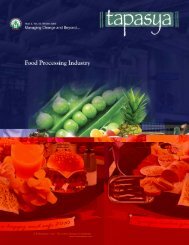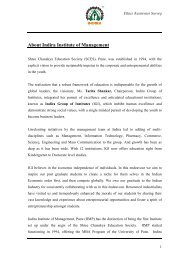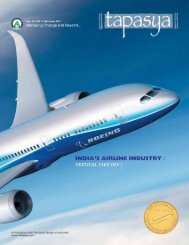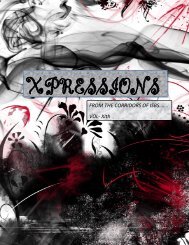Impact Of Working Capital Management On Firmsloans to steel firms for larger period of time, so as to keep the production run smoothly.All the above reasons culminate into the fact that CCC has a positive and significant correlationwith ROTA as explained by the model which rejects the null hypothesis that CCC has no impact onprofitability. The results of the study are different from those observed in the previous studieswhere CCC was negatively and sig related to profitability.The models also reject the null hypothesis that firm size has no statistically significant effect onthe profitability and the positive sign of the coefficient points to the fact that as the firms' sizeincreases, its profitability also increases.The model does not reject the null hypothesis that gearing ratio (Debt-Equity ratio) does nothavea significant effect on the profitability. The use of long term funds in WCM of the firms as shown bygearing ratio does not come out as significant for steel industry. This might be due to the fact thatthe steel firms heavily use the long term funds to finance the working capital needs. One of themajor reasons for the higher gearing ratio observed for the steel industry may be due toincreasing overheads in steel production because of the rising prices commodity and higherprices of fuel and power used in its production.9.5 TRENDS IN WORKING CAPITAL VARIABLES IN STEEL INDUSTRYTable 9.5: Trends in Working Capital Variables in Steel Industry for the period (2007-2011)Ratios 2007 2008 2009 2010 2011 5-year AverageROTA 13% 15% -10% 4% 11% 7%Debt/ Equity 4.44 4.53 5.57 5.40 6.14 5.22Current Ratio 3.52 3.55 3.33 5.27 4.89 4.11Quick Ratio 2.40 2.44 2.20 3.40 3.42 2.77Current AssetsTurnover Ratio3.00 3.05 2.96 2.78 3.59 3.08The above table shows the trends in the various components affecting working capital needs of thesteel industry. As can be noted in the above table, there has been a continuous rise in debt equity ratiofrom 4.44 in 2007 to 6.14 in 2011. The debt equity ratio is higher in the steel industry against thestandard ratio of 2:1. This may be because of the huge demand of debt funds in this industry owing tolarger Cash conversion cycle due to which short term financing is met from long term funds. Also,there is a continuous rise seen in current and quick ratio as well except for 2009 which can beattributed to rising level of inventory, accounts receivable and accounts payable. The current ratio isalso higher as against the standards of 1:1 for Current ratio. The trends in ROTA level indicate aninitial high in 2007 and 2008 after which there is a dip in 2009 and after that is showing rising trend in2010 & 2011. 2009 may be a year of slack demand with rising inventory and Accounts receivable as isevident from higher levels of Current and Quick ratio and lower demand due to recessionary effects.The current asset turnover ratio is seen at an average of 3.08 during the five year period which showsthat efficiency in production has been consistent without any major breakthrough in technology orproduction.These trends authenticate the findings obtained from the regression analysis which shows a positivecorrelation and regression coefficients between various components of working capital likeInventory days, AR days, CCC and ROTA.14 <strong>Indira</strong> Management Review - Jan <strong>2013</strong>
Impact Of Working Capital Management On Firms10. CONCLUSIONS & LIMITATIONS:1.Working Capital elements (AP days, ARdays, inventory days) significantly impactsthe profitability of the automobile firms.2. The higher the cash conversion cycle,higher is the profitability as measured by theROTA and vice versa. This is an interestingfinding as against the previous studies thatshowed negative relation between workingcapital elements and CCC.3. As the size of automobile firm increases,the profitability also increases.4. Gearing Ratio is not significantly relatedwith ROTA.5. The industry shows conservative policy interms of managing working capital duringthe time period (2007-2011) as is evidentfrom the high Current and quick ratios.6. The industry is highly leveraged at leastduring the time period (2007-2011) inconsideration with an average of 5.22 duringthe five years under consideration.Thismight be due to the fact that the steel firmsheavily use the long term funds to finance theworking capital needs. One of the majorreasons for the higher gearing ratio observedfor the steel industry may be due toincreasing overheads in steel productionbecause of the rising prices commodity andhigher prices of fuel and power used in itsproduction.7. The returns generated by the industryaregenerallyconsistent during the periodexcept for 2009 when there is a dip due torecessionary effect.The limitations would include:1. The data might not be available for certainparameters involved in the study.2. Some specific sectors/ industries may beleft out to be studied under this research.3. The results and findings might not be truefor smaller firms with less of capital andfunds at hand.4. Inflation could not be taken intocontemplation in the present study. It was notpossible to convert the relevant financial datainto their present values because of nonavailabilityof sufficient information requiredfor the purpose.11. References1. Anand, M. (2001): "Working Capital performance ofcorporate India: An empirical survey", Management &Accounting Research, 4(4), 35-65.2.Berryman, J. (1983): "Small Business Failure andBankruptcy: A survey of the Literature", European SmallBusiness Journal, 1(4), 47-59.3.Bhunia, A. and Das, A. (2012): "Affiliation betweenWorking Capital Management and Profitability",Interdisciplinary Journal Of Contemporary Research InBusiness, 3(9), 957-9684.Burns, R and Walker, J. (1991): "A Survey of WorkingCapital Policy among Small Manufacturing Firms",TheJournal of Small Business Finance, 1 (1), 61-74.5.Corporate Catalyst India Report on Indian steelIndustry, March 2012.6.Deloof, D. (2003): "Does Working Capital Managementaffect Profitability of Belgian Firms"? Journal ofBusiness Finance and Accounting, 30 (3 & 4), 573 - 587.7.Dunn, P. and Cheatham, L. (1993): "Fundamentals ofSmall Business Financial Management for Start-up,Survival, Growth, and Changing EconomicCircumstances", Managerial Finance, 19(8), 1-13.8.Fischer, E.O., R. Heinkel, and J. Zechner, (1989):Dynamic Capital Structure Choice: Theory and Tests,Journal of Finance, 44, 19-40.9.Filbeck, G. and Krueger, T. M. (2005): "An analysis ofworking capital management results across industries",American Journal of Business, Vol. 20, Issue 2, pp. 11-18.10. Gill, A., (2011): Factors that Influence WorkingCapital Requirements in Canada, Economics andFinance Review, 1(3), 30 - 40.11. Ganesan, V. (2007): An analysis of working capitalmanagement efficiency in telecommunicationequipment industry. Rivier Academic Journal, 3(2), 1-10.12. Gitman, L. J. (1994): Principles of ManagerialFinance, 7th Ed. Harper Collins, pp. 646-652.13. Howorth C., P. Westhead (2003): 'The focus ofworking capital management in UK small firms','Management Accounting Research, BlackwellPublishing, 14, 97-111.14. Jose, M. L., C. Lancaster, and J. L. Stevens, (1996):<strong>Indira</strong> Management Review - Jan <strong>2013</strong> 15








